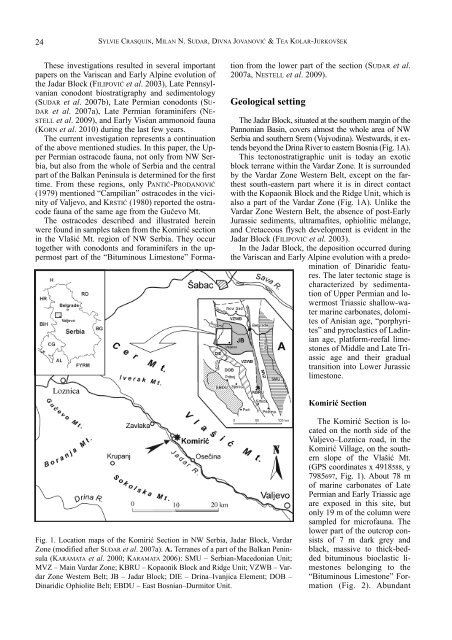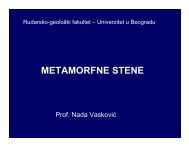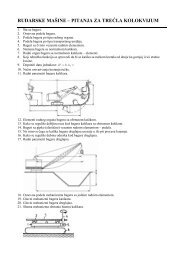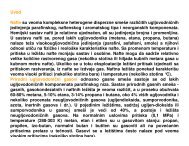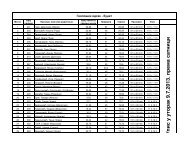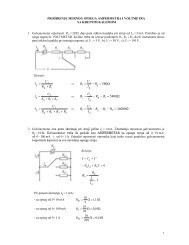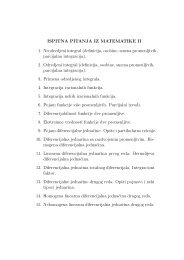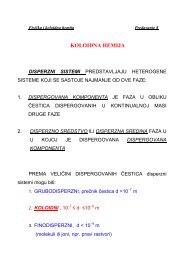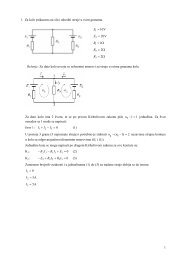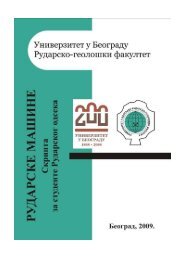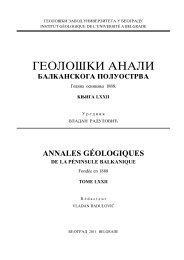KÑига LXXI - Univerzitet u Beogradu
KÑига LXXI - Univerzitet u Beogradu
KÑига LXXI - Univerzitet u Beogradu
Create successful ePaper yourself
Turn your PDF publications into a flip-book with our unique Google optimized e-Paper software.
24<br />
SYLVIE CRASQUIN, MILAN N. SUDAR, DIVNA JOVANOVIĆ & TEA KOLAR-JURKOVŠEK<br />
These investigations resulted in several important<br />
papers on the Variscan and Early Alpine evolution of<br />
the Jadar Block (FILIPOVIĆ et al. 2003), Late Pennsylvanian<br />
conodont biostratigraphy and sedimentology<br />
(SUDAR et al. 2007b), Late Permian conodonts (SU-<br />
DAR et al. 2007a), Late Permian foraminifers (NE-<br />
STELL et al. 2009), and Early Viséan ammonoid fauna<br />
(KORN et al. 2010) during the last few years.<br />
The current investigation represents a continuation<br />
of the above mentioned studies. In this paper, the Upper<br />
Permian ostracode fauna, not only from NW Serbia,<br />
but also from the whole of Serbia and the central<br />
part of the Balkan Peninsula is determined for the first<br />
time. From these regions, only PANTIĆ-PRODANOVIĆ<br />
(1979) mentioned “Campilian” ostracodes in the vicinity<br />
of Valjevo, and KRSTIĆ (1980) reported the ostracode<br />
fauna of the same age from the Gučevo Mt.<br />
The ostracodes described and illustrated herein<br />
were found in samples taken from the Komirić section<br />
in the Vlašić Mt. region of NW Serbia. They occur<br />
together with conodonts and foraminifers in the uppermost<br />
part of the “Bituminous Limestone” Formation<br />
from the lower part of the section (SUDAR et al.<br />
2007a, NESTELL et al. 2009).<br />
Geological setting<br />
The Jadar Block, situated at the southern margin of the<br />
Pannonian Basin, covers almost the whole area of NW<br />
Serbia and southern Srem (Vojvodina). Westwards, it extends<br />
beyond the Drina River to eastern Bosnia (Fig. 1A).<br />
This tectonostratigraphic unit is today an exotic<br />
block terrane within the Vardar Zone. It is surrounded<br />
by the Vardar Zone Western Belt, except on the farthest<br />
south-eastern part where it is in direct contact<br />
with the Kopaonik Block and the Ridge Unit, which is<br />
also a part of the Vardar Zone (Fig. 1A). Unlike the<br />
Vardar Zone Western Belt, the absence of post-Early<br />
Jurassic sediments, ultramafites, ophiolitic mélange,<br />
and Cretaceous flysch development is evident in the<br />
Jadar Block (FILIPOVIĆ et al. 2003).<br />
In the Jadar Block, the deposition occurred during<br />
the Variscan and Early Alpine evolution with a predomination<br />
of Dinaridic features.<br />
The later tectonic stage is<br />
characterized by sedimentation<br />
of Upper Permian and lowermost<br />
Triassic shallow-water<br />
marine carbonates, dolomites<br />
of Anisian age, “porphyrites”<br />
and pyroclastics of Ladinian<br />
age, platform-reefal limestones<br />
of Middle and Late Triassic<br />
age and their gradual<br />
transition into Lower Jurassic<br />
limestone.<br />
Komirić Section<br />
Fig. 1. Location maps of the Komirić Section in NW Serbia, Jadar Block, Vardar<br />
Zone (modified after SUDAR et al. 2007a). A. Terranes of a part of the Balkan Peninsula<br />
(KARAMATA et al. 2000; KARAMATA 2006): SMU – Serbian-Macedonian Unit;<br />
MVZ – Main Vardar Zone; KBRU – Kopaonik Block and Ridge Unit; VZWB – Vardar<br />
Zone Western Belt; JB – Jadar Block; DIE – Drina–Ivanjica Element; DOB –<br />
Dinaridic Ophiolite Belt; EBDU – East Bosnian–Durmitor Unit.<br />
The Komirić Section is located<br />
on the north side of the<br />
Valjevo–Loznica road, in the<br />
Komirić Village, on the southern<br />
slope of the Vlašić Mt.<br />
(GPS coordinates x 4918588, y<br />
7985697, Fig. 1). About 78 m<br />
of marine carbonates of Late<br />
Permian and Early Triassic age<br />
are exposed in this site, but<br />
only 19 m of the column were<br />
sampled for microfauna. The<br />
lower part of the outcrop consists<br />
of 7 m dark grey and<br />
black, massive to thick-bedded<br />
bituminous bioclastic limestones<br />
belonging to the<br />
“Bituminous Limestone” Formation<br />
(Fig. 2). Abundant


